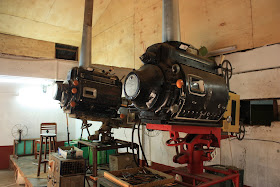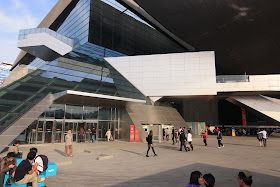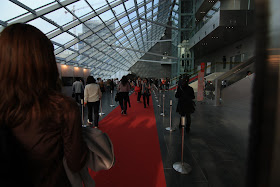Highway 9 is the Lao portion of a trans-Mekong Sub Region road expected to link the port of Danang on Vietnam's eastern seaboard with the coast of Burma. The Vietnamese, Lao and Thai portions of this road are already up and running, thanks in large to Japanese (JICA) development grants. Fractious Burma, on the other hand, has yet to be linked.
This flurry of activity on the northern end of Savannakhet, stimulated by international trucking and investment, has yet to jump start the old French-colonial core to the south, which functions at a sleep walkers' pace; partially inhabited, partially inebriated, partially fixed in a malaise of disinvestment 36 years in the making.
But from the SEA Movie Theater Project's perspective, there is one change to the town's historic core that is of epic importance: the former Nang Lit Cinema has been revived.
 In mid- 2010, the Nang Lit was leased out by a private exhibitor and has been quietly back in the movie business ever since. Screenings are not daily, unfortunately, a luxury made unfeasible by a dearth of incoming films and a population so small that the market is saturated after only a handful of screenings.
In mid- 2010, the Nang Lit was leased out by a private exhibitor and has been quietly back in the movie business ever since. Screenings are not daily, unfortunately, a luxury made unfeasible by a dearth of incoming films and a population so small that the market is saturated after only a handful of screenings.
During my five nights in Savannakhet, the revived Nang Lit - now called the Khounsavan Cinema - sat dormant, its battered carbon-arc projectors motionless on their mounts. The next scheduled film wasn't until early January.
 The honeycomb-yellow paint job over the vented upper lobby wall tastefully accents this unique architectural feature. But the new sign is about as bad as you can get.
The honeycomb-yellow paint job over the vented upper lobby wall tastefully accents this unique architectural feature. But the new sign is about as bad as you can get.
 One of the most unique facades I've seen on a theater anywhere. Too bad the original free-standing letters are missing from above the cornice.
One of the most unique facades I've seen on a theater anywhere. Too bad the original free-standing letters are missing from above the cornice.
 Here's the view of upper lobby, the reverse side of the perforated wall. The vented aspect is a fairly common architectural feature among mid-20th century theaters in Southeast Asia. When many of these theaters were built, consistent electricity supply was lacking. Theaters were powered by diesel generators (still the case in Burma). Perforated walls and open air lobbies thus served as shady, cool waiting spaces without squandering valuable energy on A/C.
Here's the view of upper lobby, the reverse side of the perforated wall. The vented aspect is a fairly common architectural feature among mid-20th century theaters in Southeast Asia. When many of these theaters were built, consistent electricity supply was lacking. Theaters were powered by diesel generators (still the case in Burma). Perforated walls and open air lobbies thus served as shady, cool waiting spaces without squandering valuable energy on A/C.
 Up leads to the projection room, down to the lower lobby.
Up leads to the projection room, down to the lower lobby.

 Tiled balcony entrance arch.
Tiled balcony entrance arch.
 The back rows of the balcony are extremely steep, well above the top of the screen.
The back rows of the balcony are extremely steep, well above the top of the screen.
 Two carbon-arc projectors made by the Peerless company, formerly of Omaha, Nebraska. The projectors date to the Nang Lit's redesigning back in 1970.
Two carbon-arc projectors made by the Peerless company, formerly of Omaha, Nebraska. The projectors date to the Nang Lit's redesigning back in 1970.


 The honeycomb-yellow paint job over the vented upper lobby wall tastefully accents this unique architectural feature. But the new sign is about as bad as you can get.
The honeycomb-yellow paint job over the vented upper lobby wall tastefully accents this unique architectural feature. But the new sign is about as bad as you can get. One of the most unique facades I've seen on a theater anywhere. Too bad the original free-standing letters are missing from above the cornice.
One of the most unique facades I've seen on a theater anywhere. Too bad the original free-standing letters are missing from above the cornice.
A lapse in operation didn't keep me from getting into the old Nang Lit. The caretaker/projectionist, a Mr. Mith, was kind enough to open the gates and show me around the theater's inner sanctums.
A ten year veteran of the building, Mith claimed that current Nang Lit, dating to around 1970, was built as an upgraded version of a much older wooden theater which preceded it. The original owner, a Laotian of Chinese descent, named the theater after his daughter, 'Lit,' operating it in stiff competition with another three theaters which once vied for the patronage of Savannakhet's entertainment seekers.
In the wake of Pathet Lao ascendancy - May, 1975 - the owner and his family crossed over into Thailand en route to refuge in America, forever relinquishing their cinema to memory and seizure by the communist regime. But to this day, the family legacy is easily one of the most striking buildings to grace Savannakhet's gridded streets.
 Here's the view of upper lobby, the reverse side of the perforated wall. The vented aspect is a fairly common architectural feature among mid-20th century theaters in Southeast Asia. When many of these theaters were built, consistent electricity supply was lacking. Theaters were powered by diesel generators (still the case in Burma). Perforated walls and open air lobbies thus served as shady, cool waiting spaces without squandering valuable energy on A/C.
Here's the view of upper lobby, the reverse side of the perforated wall. The vented aspect is a fairly common architectural feature among mid-20th century theaters in Southeast Asia. When many of these theaters were built, consistent electricity supply was lacking. Theaters were powered by diesel generators (still the case in Burma). Perforated walls and open air lobbies thus served as shady, cool waiting spaces without squandering valuable energy on A/C. Up leads to the projection room, down to the lower lobby.
Up leads to the projection room, down to the lower lobby.
 Tiled balcony entrance arch.
Tiled balcony entrance arch. The back rows of the balcony are extremely steep, well above the top of the screen.
The back rows of the balcony are extremely steep, well above the top of the screen. Two carbon-arc projectors made by the Peerless company, formerly of Omaha, Nebraska. The projectors date to the Nang Lit's redesigning back in 1970.
Two carbon-arc projectors made by the Peerless company, formerly of Omaha, Nebraska. The projectors date to the Nang Lit's redesigning back in 1970.
In the projection room, I chanced on some enticements beyond the theater's architectural craftmanship. There on the floor, beside two old carbon-arc projectors sat reels of film, some partially unraveled, others neatly stored in boxes. "What's on these?" I inquired of Mith.
"Old movies," he replied nonchalantly. "Mostly from India."
Now, it must be kept in mind that in all of my theater explorations, only once or twice have I encountered coveted reels of old film. Movie collectors and film preservationists have been known to pay handsomely for original movie prints. A few years ago, 25 minutes worth of footage cut from Fritz Lang's silent classic Metropolis, long believed destroyed, was rediscovered in Argentina. The full length version has since been restored and released in theaters around the world.
Recalling the Metropolis case, dreams of fortunes made from the sale of original movie prints crept into my brain. I could fund this project for the next three years if I got hold of a rare film, I schemed, maybe even put some money in my pocket.
"Would you be interested in selling any of these prints," I opened, imagining a copy of some long-forgotten title from Bengali director Satyajit Ray among the stock.
"No, sir. They are not for sale."
Oh well, at least I tried.

So I didn't walk out of the Nang Lit Cinema cradling thousands of dollars worth of rare Indian movie prints from the 1970's. Anyway, all the money in the world pales in comparison with the satisfaction of having seen - with my own two eyes - the tepid revival of one of Laos' few remaining stand-alone movie palaces.
Happy New Year all!





















































